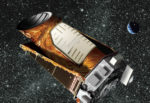Excitement About Exoplanets
Psalm 19:1
“The heavens declare the glory of God; and the firmament sheweth his handywork.”
 There has been a considerable amount of interest over exoplanets recently. This is due, in large part, to information gleaned from the Kepler spacecraft, which was launched in 2009. Data started being made available from the spacecraft in 2014. There is too much data to be studied quickly by NASA or anyone else, so the data has been made freely available, and anyone with the expertise to analyze the data can do so. This has led to the discovery of a lot of new exoplanets. My friend and fellow creation speaker, Dr. Jason Lisle, discovered a planet using this data and made that discovery known in May 2017.
There has been a considerable amount of interest over exoplanets recently. This is due, in large part, to information gleaned from the Kepler spacecraft, which was launched in 2009. Data started being made available from the spacecraft in 2014. There is too much data to be studied quickly by NASA or anyone else, so the data has been made freely available, and anyone with the expertise to analyze the data can do so. This has led to the discovery of a lot of new exoplanets. My friend and fellow creation speaker, Dr. Jason Lisle, discovered a planet using this data and made that discovery known in May 2017.
What is an exoplanet? An exoplanet is a planet orbiting a star other than our own sun. You might suppose that they were discovered by peering through a telescope in the same way that planets like Uranus and Neptune and the dwarf planet Pluto were discovered. However, this is not the case. The data released by Kepler, orbiting beyond the haze of the atmosphere, comprises of readings of brightness from many stars. If a planet orbits across the surface of that star, then the brightness of the star will be imperceptibly, but measurably, diminished. If observed dips in the stellar brightness are observed regularly, then it can be assumed that this regularity is due to the regularity of an orbiting planet.
In considering these discoveries, one is impressed by the beauty and majesty of God’s creation. One is also impressed by the talents that He has given to those who analyze such data for these discoveries. Author: Paul F. Taylor
Prayer: Thank You Father, that You have blessed human beings with brains and intellect, that they can use to further Your glory. We pray that many of these scientists will come to know God, whose glory is visibly declared by the objects that they study. Amen.
Ref: Technical University of Denmark. “Scientists discover almost 100 new exoplanets.” ScienceDaily. ScienceDaily, 15 February 2018. <www.sciencedaily.com/releases/2018/02/180215105756.htm>. Image: NASA, Public Domain.